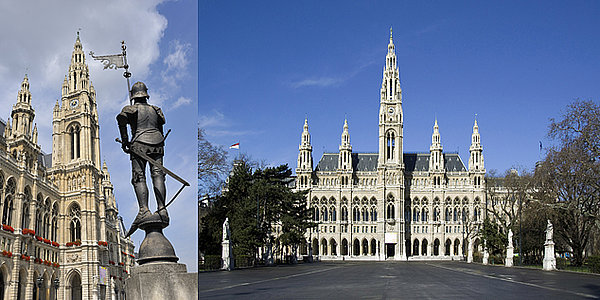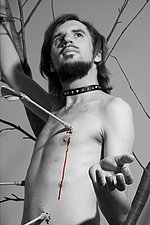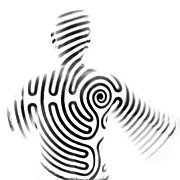Social program
- Welcome reception at the arcades of the University after conference opening ; June, 2nd (Thursday, 7.30 pm)
- Mayor’s reception at the Vienna City Hall; June, 3rd (Friday, 7.30 pm)
- Conference dinner at the Palmery; June, 4th (Saturday, 7.30 pm)
- Art Exhibition: "Trauma Touching Art" by Martina Gasser (Vernissage Friday, June 3 at 10:45-11:15 during coffee break in the conference Cafe)
- Accompanying persons program
Mayor’s reception at the Vienna City Hall // June 3, 2011 at 8 pm

The Vienna City Hall
The monumental building on Vienna’s Ringstrasse was erected between 1872 and 1883 according to designs by Friedrich Schmidt (1825–1891). The City Hall is 152 metres wide and 127 metres long, covering a built-up area of 19,592 square metres, with a total surface of 113,000 square metres. Its façade is a splendid example of secular architecture in neo-Gothic style but also features individual Renaissance elements. The building’s exterior design, especially the 103-metre-high steeple, is inspired by the tradition of Flemish city halls during the Gothic period, thus reflecting the medieval tradition of civic freedom. The floor plan, by contrast, is more similar to the layout of a typical Baroque palace. It is therefore difficult to classify the building’s architecture as strictly neo-Gothic. The many rooms of the Vienna City Hall include the offices of the Mayor and the Council Chamber where the Vienna City Council convenes. As Vienna is both a federal province and a city, the City Council members also form the Provincial Parliament of Vienna.
The Rathausmann
The iron standard-bearer atop the City Hall steeple is generally known as the Rathausmann. It weighs 650 kilograms and is 5.4 metres high (including the standard). The Rathausmann would have some trouble finding comfortable footwear – he takes size 63 (size 29 in GB). The statue is held in place by a counterweight of 800 kilograms, enabling it to sway up to 25 centimetres from the vertical in high winds. The Rathausmann was crafted by artisan metalworker Alexander Nehr to a design by Franz Gastell. Since its renovation in 1984/85, an exact copy of the standard-bearer stands in the park in front of the City Hall (Rathauspark).
The Arkadenhof and the Grand Staircases
With a surface of 2,804 square metres, the Arkadenhof is one of the biggest inner courtyards in Europe. An oriel along its western wall is a reminder of the original project to build a chapel in the City Hall. Lined by five-metre-wide arcades, the courtyard offers a fascinating setting for a wide variety of events. A specially designed folding roof protects visitors against wind and rain.
The two Grand Staircases with their broad flights of stairs and wrought-iron railings are bathed in brilliant light effects created by multi-coloured tracery windows. As everywhere in the building, stones from different regions of the Austro-Hungarian Monarchy were used. The mezzanine features the longest cloakroom of Austria: designed in historicist style, it is 50 metres long and has room enough for 1,700 coat hooks.
The Festival Hall
When it was built in the late 19th century, the Festival Hall was the biggest hall in the whole country – 71 metres long, 20 metres wide and 18.5 metres high. The ceiling was designed as a barrel-type vault with a web compartments and raised cross ribs as decorative elements. Numerous arcades and the gallery loggia enhance the impression of vast, airy space. The corners of the two orchestra niches are decorated with relief portraits of four great composers: Mozart, Haydn, Gluck and Schubert. Lighting is provided by 16 chandeliers. The parquet floor is made of special oak preserved for centuries in upland bogs, and was reconstructed in 1999 according to the original plans
The Palmery at the Burggarten in Vienna // Location for conference dinner

The conservatory (“Palmenhaus”) in the Burggarten was constructed during the epoch of Historicism and nature was substituted by "urban green". Upon demolition of a structure dating back to 1698, an orangery was built in the Burggarten in 1823–26 by Ludwig von Remy, Imperial and Royal Councillor and Head of the Court Construction Directorate. Designed to emulate the Schönbrunn conservatory, the orangery was a Classicist greenhouse of some 130 metres in length and served in its original capacity until the turn of the century. Razed in 1901, it was replaced by a "new" palmery which was designed by Court Architect Friedrich Ohmann and which was recently given a complete refurbishment.
The palmery is a late specimen of the fashion for architectural conservatory construction. In its early years it was used for different purposes ranging from the winter garden of the imperial palace to simply a flower room or a greenhouse.

- © VBK // Martina Gasser
MARTINA GASSER
“TRAUMA TOUCHING ART“
Art exhibition during the 12th ECOTS conference at the University of Vienna - Großer Festsaal, 3-5 June 2011
Vernissage: Friday, 3rd June at 10.45-11.15 am during coffee break at the conference cafe
“In 1998, Martina Gasser projects in a performance a 100-fold magnified finger print of a thumb tip onto herself, a camera being her only witness. Like a camouflage this seemingly untreacherous evidence and symbol of individuality gives rise to formations that seemingly dissolve Gassers face and body, plainly her whole identity is deformed.”
Text: Marlene Gölz, 2011
Martina Gasser presents a selection of her works, which deal with the issues of her identity, dissolution and damage. Some works are playing with ambiguities, leaving space for free associations by the spectator.
The series “Labyr Marritime” from 1997, in which a labyrinth is projected onto the body of the artist, strikes on first observation with its strict, graphical composition and aesthetic. The labyrinth without wrong tracks, but the longest possible way to the center, describes a parable to life, death being the goal. When watching the photographs longer and reading the complementary title of the particular series (e.g. centre/bull’s eye) the woman can suddenly be viewed as a target through the eye of a sniper.
The photos and paintings “Dactyl Marritime” counteract the term of individuality of one’s own unique fingerprint.
“In art, the equivalent to a fingerprint is the distinctive brushstroke, displaying the personality of the artist – however, searching for this in the artist’s paintings is mostly in vain. Gasser projects her enlarged fingerprint banishing it onto a scrupulously sleek canvas, whereby she caricatures the seeming spontaneity, with which such a print is normally produced, and the evidence of artistic authorship.”
Text: Marlene Gölz, 2011
In her works “St. Sebastian modern” from 2010/2011 the arrow struck Sebastion beholds the viewer with a blend of provocation, pride and masochistic ecstasy. As in “Labyr maritime” the viewer finds himself positioned as a voyeur or offender. In every case, one is on the other side.
Text: Martina Gasser 2011
Bio Martina Gasser:
1975 Born in Innsbruck, Tyrol / Austria
1995- 1997 College for Photography at the “Graphische BLVA” - Vienna
1997-2003 Academy of Fine Arts – Master school for Photography, Graphic Arts and Painting
2002-2009 Foundation and co-foundation of "Atelier SyndikART" and the art-association “SyndikART” as atelier and melting point of artistic collaboration and communication (organisation and conception of different art projects)
-> www.syndikart.org
2007 JosefFranz Würlinger Preis // Andechsgalerie Innsbruck
Martina Gasser created and sponsored the 12th ECOTS conference logo and was part of the organizational team of ECOTS . She lives and works in Vienna (Contact: www.martinagasser.eu)


